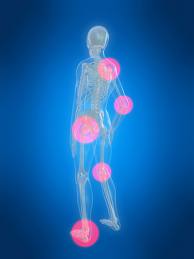Have you started to notice that you may not be quite as supple as you remember? Maybe you can’t quite reach your toes like you used to; or, perhaps climbing the stairs is causing you some knee pain? You might think it’s finally happening – you are getting older!
The questions naturally follow: Why do my joints hurt as I age? What can I do about it?
As you age, it becomes increasingly common for your joints to become stiff, swollen and painful. This may be likely due to wear and tear, aggravated by inactivity, injury or even engagement in high impact sport as a youngster. These processes place pressure on the joint and cause the cartilage, a component of joint tissue which absorbs impact and lubricates movement, to become damaged. The joint then becomes inflamed, swollen and painful, making it difficult to move around. This swelling and inflammation often leads to further degradation. Over time, the end result may be mild osteoarthritis which can hinder your ability to perform those activities that you enjoy.
The good news is, while mild arthritis becomes increasingly common with age, there are things you can do to help maintain healthy joints. Doing regular exercises, at an appropriate intensity, and eating a healthy, anti-inflammatory diet (lots of vegetables and good fats) may contribute to keeping your joints healthy.
A Turning Point for Painful Joints?
 What Natural Medicine can help protect joints and relieve joint pain?
What Natural Medicine can help protect joints and relieve joint pain?
There may be a number of nutrients that spring to mind but glucosamine and dimethyl sulfone (also called methylsulfonylmethane, or MSM) should be among the first.
Glucosamine may support joint health and relieve pain by:
- helping to repair damaged cartilage tissue;
- helping to produce synovial fluid, a joint lubricant that helps to reduce friction; and,
- reducing inflammation.
Glucosamine comes in a couple of different forms but glucosamine sulfate has been found to be superior for reducing the symptoms associated with mild osteoarthritis.1
MSM also has a number of properties that make it valuable for improving joint pain. Specifically, MSM may directly reduce inflammation (which leads to cartilage damage) and is an effective natural pain reliever.
Give Mild Arthritis the Slip with Fish Oils
Fish oils are famous for their multitude of health benefits, particularly when it comes to mild arthritis. Arthritis Australia strongly recommends fish oil to reduce inflammation and the pain and stiffness associated with mild arthritis. However, to be effective, fish oils need to be taken on an ongoing basis at a dose of 2.7 g of omega-3 daily.
Four Tips to Keep You Limber for Longer
Supplements such as good quality fish oil may provide significant benefit for the symptoms of mild arthritis, but there is more that you can and should be doing. Diet and lifestyle are crucial for all aspects of health, including maintaining healthy joints.
The following four tips are simple but they can have a big impact on helping you stay limber for longer:
- Exercise – you know it is important to be active for general wellbeing, but exercise really is crucial to maintain healthy joints as cartilage relies on movement for nutrient delivery and clearance of waste materials. Yoga, Pilates and aqua aerobics are particularly gentle yet effective exercise options if you currently have mild arthritis.
- Remove any ‘pain promoting’ foods – diet is extremely important to maintain all aspects of health and your joints are no different. Minimise or eliminate caffeine, alcohol, sugar, packaged/processed foods and deep fried/take away food as they may all contribute to increased inflammation, which can lead to pain.
- Increase your intake of ‘anti-inflammatory’ – eat 4 to 5 handfuls of different coloured vegetables each day, including plenty of green leafy veggies. Choose unrefined whole grains, 2 to 3 pieces of fruit, and 1 to 2 handfuls of foods rich in good fats, i.e., oily fish, avocado, nuts, seeds or flaxseed oil, etc. Make sure also you drink 2 L of water each day to help keep your joints hydrated.
- Take advantage of complementary therapies – acupuncture, physiotherapy, podiatry, massage and osteopathy may all help to stretch or strengthen the muscles around joints to improve their range of motion.
Diet and lifestyle choices play a huge part in maintaining good joint health.
These four simple tips are meant keep your joints moving and strong. By making these a part of your daily life, you will be able to lead an active, healthy lifestyle and keep up with the younger generations.


2 Responses
Donna McPherson
What advice did you give this morning re: arthritic pain? I came in on the end of the call.
F. Elvy
I have a 18 year old Grandaughter who has a Urinary infection – is there something beside antibiotics can she use for this – Thank you